

 |
||
 |
||
Vol. 11 (2): November 2008 |
||
Gibraltar / Greece / Italy / Madeira / Mauritania & Western Sahara / Spain / Turkey
Gibraltar
|
|||||||||||||
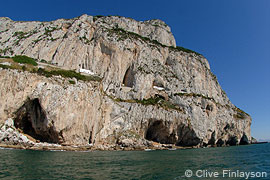 |
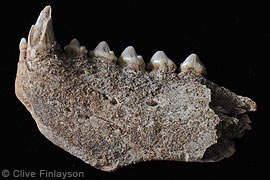 |
|
|
Caves once occupied by Neanderthals at the Rock of Gibraltar, including Bennett’s, Gorham’s, and Vanguard. Credit: Clive Finlayson, Gibraltar Museum. |
Lower jaw of a Mediterranean monk seal found in the Vanguard cave, Gibraltar. Credit: Clive Finlayson, Gibraltar Museum. |
Stringer, C.B., J.C. Finlayson, R.N.E. Barton, Y. Fernández-Jalvo, I. Cáceres, R.C. Sabin, E.J. Rhodes, A.P. Currant, J. Rodriguez-Vidal, F. Giles-Pacheco, and J.A. Riquelme-Cantal. 2008. Neanderthal exploitation of marine mammals in Gibraltar. Proceedings of the National Academy of Sciences of the United States of America PNAS 105(38): 14319-14324. [Abstract]
Natural History Museum. 2008. Neanderthal diet like early modern human’s, 23 September 2008.
Sample, I. 2008. Neanderthals had a taste for seafood. Our doomed cousins the Neanderthals clung to life in seaside caves in Gibraltar by eating mussels, baby seals and dolphins. The Guardian, 22 September 2008.
Neanderthals hunted marine mammals
Alongside the butchered bones of land mammals including wild boar, bear, ibex, red deer and rabbit in the caves the experts also found the bones of young monk seals and bottlenose dolphins.
“The seal bones we found have clear cut marks and peeling, from Neanderthals bending and ripping them from the body to remove meat and marrow,” said Stringer, while “the mussel shells had been warmed on a fire to open them.” […]
Peter Brown, a palaeoanthropologist of the University of New England in Armidale, Australia, said it’s great to have more evidence of the diversity of behaviours in human relatives, but that he was “not all that surprised that Neanderthals were smart enough to use adjacent marine resources at Gibraltar.”
Brown argued that for both of the marine mammals found in the caves, the numbers are very small, “suggesting a rare opportunity, perhaps scavenging, rather than the regular targeting of species.” Young monk seals would have been easy to surprise on the beach, he said, while the dolphins eaten may have been stranded.
Neanderthals hunted marine mammals, John Pickrell, Cosmos, 23 September 2008.
Neanderthals ate seals and dolphins
The diet of prehistoric Neanderthals living in caves on the Rock of Gibraltar included seals and dolphins, showing once again that the hominids had skills rivaling those modern humans living then, according to a new study.
The discovery of seal, dolphin and fish remains in the caves dating from 60,000 to 30,000 years ago provides the first evidence that Neanderthals ate sea mammals as well as land grub.
Archaeologists found the mammals’ remains among Neanderthal hearth sites in Vanguard and Gorham’s Caves on the Rock of Gibraltar. The bones of some of the animals have cut marks that were likely made by Neanderthals using flint knives, also found on site, to cut the meat off.
“Deep down there is this idea that modern humans are cognitively superior and therefore able to outcompete Neanderthals,” said researcher Clive Finlayson, director of the Heritage Division at the Gibraltar Museum. “I suppose we’ve thrown a bit of a spanner in the works by showing that Neanderthals were doing exactly the same thing.”
The researchers can’t be sure how the ancient Neanderthals hunted their seafood, but suggest that perhaps Neanderthals used clubs to kill seals that came close to the beach to have their pups. This skill might have involved knowledge of the seasons, and prediction of seal birthing time. And maybe they snatched dolphins that swam too close to shore, or got stranded on the beach. […]
Neanderthals ate seals and dolphins, Clara Moskowitz, LiveScience, 22 September 2008.
Research efforts by MOm during the past decade have highlighted the islands of Karpathos and Saria, in the Southern Dodecanese, as one of the most important breeding locations of Mediterranean monk seals in the eastern Mediterranean, with a mean annual pup production of approximately four animals.
The recent establishment of the management body of the Northern Karpathos-Saria Ecodevelopment Area, which was created within the framework of national efforts to manage and safeguard the country’s natural heritage, provided the opportunity for the establishment of a permanent monitoring scheme for Monachus monachus in the protected area of northern Karpathos and the island of Saria.
With that aim in mind, MOm undertook the task of preparing and running such a monitoring scheme for the year 2008. MOm researchers, in collaboration with the staff of the management body, initially visited, mapped and evaluated the 22 coastal monk seal shelters that had been previously identified; 14 in Karpathos, 5 in Saria and 3 at the remote islet of Astakida. Of these 22 caves, 3 were considered suitable for pupping, while the remaining 18 were considered suitable only for resting. Following this initial visit to the caves in February 2008, regular follow-ups are being carried out in order to record habitat use, behaviour of the species and basic demographic and reproductive parameters.
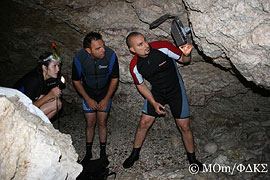 |
 |
|
|
Monitoring on Karpathos, using infrared motion detection cameras. |
||
To date, the monitoring team has recorded cave use in approximately 30% of all visits carried out and identified four females, two juveniles and six pups (two from the 2007 pupping season and four from this year’s pupping season). In addition, the deployment of three infrared motion detection cameras in two of the pupping sites has provided more than 1,300 photographs of monk seals (mainly of the four females and their pups) and important information on the reproductive behaviour of the species.
The available data and their preliminary assessment confirm the importance of the area for the survival of the species in the eastern Mediterranean and will provide essential information in its effective management and protection. – Mariana Psaradelli and Alexandros Karamanlidis, MOm.
An orphaned monk seal pup was discovered by a member of MOm’s Rescue and Information Network (RINT), following a storm on the Greek island of Evia on 19 September 2008.
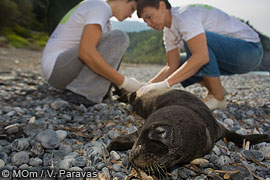
The Evia pup undergoes examination by MOm Rescue Team members.
The newborn pup, not older than 24 hours, still carried the umbilical cord.
MOm’s Athens-based Rescue Team initially provided guidance by telephone, advising the observer on Evia to remain hidden and to keep watch over the pup, in case the mother reappeared.
In the meantime, the Rescue Team travelled to the stranding site and, upon arrival, set about examining the young animal. The pup was found to be in critical condition, exceedingly weak, and with very high fever; it was exhibiting symptoms of both gastric and neurological problems. Regrettably, 45 minutes after receiving first aid and with the mother still absent, the pup died.
The necropsy, conducted with the collaboration of Prof. Dr. Thijs Kuiken, Erasmus University, Rotterdam, revealed problems in the heart, lungs, and brain of the pup. The exact aetiology of death may become apparent during laboratory examination of the samples collected. – E. Androukaki, MOm.
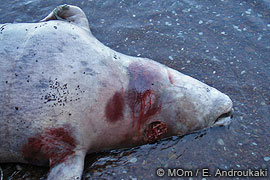
Death of a monk seal.
On 3 September 2008, port police authorities on the Aegean island of Hydra notified MOm that a dead Mediterranean monk seal had been discovered. According to the necropsy, the adult female seal’s death was due to a deep wound at the right side of the animal’s neck, caused by a sharp instrument. The advanced state of decomposition did not permit positive identification of the type of implement used in the killing.
The Mediterranean monk seal is a priority species for the EU and is protected by EU and Greek law. However, from January 2008 to date, MOm has conducted 7 necropsies, with the Hydra death being the second recorded deliberate killing incident in Greek waters during that period.
With the species critically endangered, it is evident that deliberate killing still poses a serious threat to Monachus monachus. – Calliope I. Lagonika, MOm.
MOm’s EU LIFE/Nature-funded project, focusing on the sometimes lethal interaction between monk seals and fisheries, has released its latest progress report, covering the period July 2007-June 2008.
Progress MOm highlights in the report includes:
MOm’s biannual MOFI newsletter, providing further information, is available in English and Greek.
A new TV and radio spot is now airing via national and local broadcasters, focusing on the brighter side of the uneasy relationship between fisherman and seal.
Available only in Greek, the TV spot, “Nicolas and Victoria“, can be viewed on the MOFI website. – Calliope I. Lagonika, MOm.
MOm. 2008. Monk seal and fisheries: mitigating the conflict in Greek seas. Progress report covering the project activities from 01.07.2007 to 30.06.2008. MOm /Hellenic Society for the Study and Protection of the Monk Seal: 1-33. [PDF  1.2 MB]
1.2 MB]
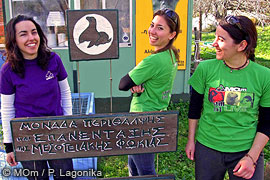
Summer volunteers on Alonissos.
It was a busy-busy summer for the 50 volunteers who spent the better part of their annual vacation helping MOm raise awareness about the Mediterranean monk seal and the marine environment.
Scattered among the islands of Alonissos, Skopelos and Kimolos and – for the first time – in Attica, they guided the 22,131 visitors to MOm’s Information Centres through the world of the elusive Monachus monachus and carried out various environmental education activities.
MOm has been carrying out its Summer Volunteers Programme in areas of importance for the monk seal since 1990. Each volunteer spends 2 weeks at the Island/Information Centre of his or her choice with costs of accommodation fully covered by MOm.
To become a MOm volunteer you need to be over 18 years of age, speak English and Greek, enjoy team work and, last but not least, care for the marine environment.
For more information about MOm’s Summer Volunteer programme, please contact us on +30 210 52 22 888 or drop us an email at . – Calliope I. Lagonika, MOm.
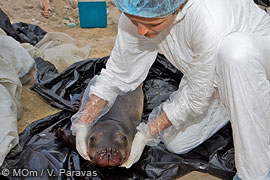
On 17 October, MOm’s research biologists were confronted by yet another deliberate killing incident, this time at the Aegean island of Milos, an area bordering the important monk seal breeding habitat of Kimolos, and also hosting a number of seal caves itself.
The dead seal was a 1-year old male that had been shot with a rifle, the bullet penetrating the animal’s left lung, the heart, and eventually becoming lodged in the chest.
Based on weather conditions in the area at the time, and on the state of decomposition, the young seal is thought to have been shot on Wednesday the 15th of October in the bay of Milos. MOm was notified of the incident by the local port police authorities.
This is the third case of confirmed deliberate killing in 2008 according to the necropsies conducted by MOm. In order to halt these crimes, MOm has requested that the port police step-up their surveillance and control for guns carried on boats, something that is already illegal. The local fishing association was also notified of the incident.
According to MOm’s 20-year research efforts, 50% of all adult seals found dead have been deliberately killed. Greek fishermen and MOm have been working together since 2005 in the EU-funded MOFI project, that aims to reduce the negative consequences of monk seal and fishery interactions. – Calliope I. Lagonika, MOm.
Problems and challenges at the Sporades Marine Park (NMPANS)
[Excerpted from an interview with Vassilis Kouroutos, biologist at the Management Body of the NMPANS]
AthensPlus: What sort of problems did you encounter?
V. Kouroutos: Protesters raided our offices, pelted us with eggs and yogurt, vandalized our boat and our cars. The worst episode, last December, was when a well-known local fisherman turned up outside my house and tried to shoot me. He shouted my name, I came out onto the balcony and he fired a gun at me. Thankfully, I ducked and wasn’t hurt.
AthensPlus: Had you had problems with this man before? Are other fishermen so hostile?
V. Kouroutos: During patrols of the no-access zone of the marine park, I spotted the same guy twice, spearfishing, which is absolutely forbidden. But he persisted. We have tried to adopt a more flexible attitude to park visitors, chiefly fishermen and tourists. Many fishermen resent us as they believe the marine park stops them from earning a living. This is ridiculous – only Piperi is out of bounds. […]
AthensPlus: So why do they covet this tiny islet?
V. Kouroutos: Fish supplies are dwindling. They don’t catch as many fish as in years gone by. So they want access to the one tiny patch they are banned from, as if that will solve their problem. They are pushing for access to Piperi except for the three months when the seals reproduce (September to November). There should be a response by the end of the year.
AthensPlus: What made you decide to devote your life to protecting the Mediterranean monk seal?
V. Kouroutos: If you could enter one of their refuges and see a seal up close, you would understand. It’s an amazing experience. They are very friendly. You pick up a baby and it suckles at your armpit or chest immediately, it doesn’t react defensively. The babies of other species of seal are not as trusting – they usually bite. The monk seals are very curious. When we enter one of their caves in our boat to check on them, they often swim around the boat to check us out. […]
– A mission to save an embattled species. Vassilis Kouroutos – A key figure in the struggle to preserve the monk seal speaks of his joys and frustrations. Niki Kitsantonis, AthensPlus, Kathimerini, 31 October 2008. [PDF  15.7MB]
15.7MB]
EndQuoteBest beaches, glorious illusions Take your pick of gorgeous beaches lining the gloriously undeveloped 25 mile coastline. Grottos, secret coves and hidden, pearly-white sands are backed by limestone cliffs, sculpted rock formations and forests of holm oak, juniper and macchia in one of Europe’s last coastal forests. Cala Luna is a white half-moon crescent lapped by crystal-clear waters, overlooking the Gulf of Orosei. On one side of the beach there are six small caves and, nearby, is the Grotta del Bue Marino, the last Sardinian hiding place of the endangered monk seal and the largest, most dramatic of the many beautiful grottos.
|
Mediterranean News continues with Italy, Madeira, Mauritania & Western Sahara, Spain and Turkey...
Copyright © 2008 The Monachus Guardian. All Rights Reserved |